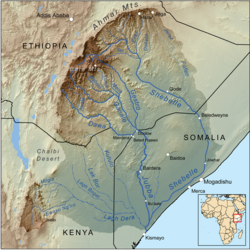The Ganale Doria River (Somali: Webiga Janaale) (also transliterated as Genale Dorya) is a perennial river in southeastern Ethiopia. Rising in the mountains east of Aleta Wendo, the Ganale flows south and east to join with the Dawa at the border with Somalia to become the Jubba. The river's tributaries include the Welmel, Weyib (also known as Gestro), and Mena. The Del Verme Falls is a notable feature of its middle course.
| Ganale Doria River | |
|---|---|
 Map of the Jubba/Shebelle drainage basin | |
 | |
| Native name | Webiga Janaale (Somali) |
| Location | |
| Country | Ethiopia |
| Regions | Oromia, Somali, Sidama |
| Physical characteristics | |
| Source | |
| • location | Ethiopian Highlands |
| • coordinates | 6°48′27″N 39°07′21″E / 6.807437°N 39.122393°E |
| • elevation | 3,479 m (11,414 ft) |
| Mouth | Jubba River |
• location | Near Dolo, at Ethiopia–Somalia border |
• coordinates | 4°10′42″N 42°04′48″E / 4.1784°N 42.0801°E |
• elevation | 175 m (574 ft) |
| Length | 858 km (533 mi) |
| Basin size | 82,600 km2 (31,900 sq mi)[1] |
| Discharge | |
| • location | Mouth[1] |
| • average | 241.5 m3/s (8,530 cu ft/s) |
| • minimum | 56.2 m3/s (1,980 cu ft/s) |
| • maximum | 531.6 m3/s (18,770 cu ft/s) |
| Basin features | |
| Progression | Jubba → Somali Sea |
| River system | Jubba Basin |
| Population | 3,940,000[2] |
| Tributaries | |
| • left | Welmel, Mena, Weyib |
| Waterbodies | GD-3 Power Station Reservoir |
According to materials published by the Ethiopian Central Statistical Agency, the Ganale has a total length of 858 km (533 mi).[3] The Ethiopian Ministry of Water Resources, describes the catchment area of the Ganale Dorya-Dawa river basin as 82,600 km2 (31,900 sq mi) in size, with an annual runoff of 5.80 billion cubic metres (205×109 cu ft), and specific discharge of 1.2 litres per second (0.042 cu ft/s) per square kilometre.[4] The catchment area is estimated as having the potential to irrigate 1,070 km2 (410 sq mi), and to generate 9270 gigawatt-hours per year.[5]
The river Ganale was renamed Ganale Doria by the Italian explorer Vittorio Bottego after the Italian biologist Giacomo Doria.[6]
The Genale Doria is historically important because it served as the boundary between Sidamo and Bale Provinces. The confluence of the Ganale Doria with the Dawa is notable as the former starting point for the boundary between Ethiopia and Kenya to the west, and the starting point for the boundary between Ethiopia and Somalia to the east.[7] In 1936, the Battle of Genale Doria was fought to the south of the river's course.
Notes
edit- ^ a b Lehner, Bernhard; Verdin, Kristine; Jarvis, Andy (2008-03-04). "New Global Hydrography Derived From Spaceborne Elevation Data". Eos, Transactions American Geophysical Union. 89 (10): 93–94. doi:10.1029/2008eo100001. ISSN 0096-3941.
- ^ Liu, L., Cao, X., Li, S., & Jie, N. (2023). GlobPOP: A 31-year (1990-2020) global gridded population dataset generated by cluster analysis and statistical learning (1.0) [Data set]. Zenodo. https://doi.org/10.5281/zenodo.10088105
- ^ "Climate, 2008 National Statistics (Abstract)" Archived November 13, 2010, at the Wayback Machine, Table A.1. Central Statistical Agency website (accessed 26 December 2009)
- ^ "Water Sector Development Program: Main Report, Volume II" Archived 2011-07-20 at the Wayback Machine, Ethiopia Ministry of Water Resources (2002), p. 12
- ^ "Nature and Features of the Ethiopian River Basins: Table 6.1, Simple Parameters Indicating the Potential of the Basin" Archived 2011-07-20 at the Wayback Machine, Ethiopian Ministry of Water Resources (accessed 12 February 2009)
- ^ V. Bottego, Il Giuba esplorato, Rome, 1895; A. Donaldson Smith, Through unknown African Countries, London, 1897; I. N. Dracopoli, Through Jubaland to the Lorian Swamp, London, 1914; C. Citerni and L. Vannutelli, L'Omo. Viaggio di esplorazione nell'Africa orientale, Milan, 1899; Regio Governo della Somalia Italiana, Il Giuba, Turin, s. a. [1926]; id., La Vallata del Giuba, Turin, s. a. [1927]; Commissariato generale dell'Oltre Giuba, Notizie sul territorio di riva destra del Giuba, Rome, 1927.
- ^ See, for example, "Ethiopia – Kenya Boundary" Archived 2009-03-18 at the Wayback Machine, U.S. State Department International Boundary Study, No. 152 – October 15, 1975